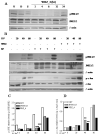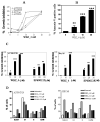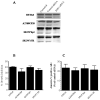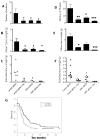c-Jun-NH2-kinase-1 inhibition leads to antitumor activity in ovarian cancer
- PMID: 20028751
- PMCID: PMC3716580
- DOI: 10.1158/1078-0432.CCR-09-1180
c-Jun-NH2-kinase-1 inhibition leads to antitumor activity in ovarian cancer
Abstract
Purpose: To show the functional, clinical, and biological significance of c-Jun-NH(2)-kinase (JNK)-1 in ovarian carcinoma.
Experimental design: Analysis of the impact of JNK on 116 epithelial ovarian cancers was conducted. The role of JNK in vitro and in experimental models of ovarian cancer was assessed. We studied the role of N-5-[4-(4-methyl piperazine methyl)-benzoylamido]-2-methylphenyl-4-[3-(4-methyl)-pyridyl]-2-pyrimidine amine (WBZ_4), a novel JNK inhibitor redesigned from imatinib based on targeting wrapping defects, in cell lines and in experimental models of ovarian cancer.
Results: We found a significant association of pJNK with progression-free survival in the 116 epithelial ovarian cancers obtained at primary debulking therapy. WBZ_4 led to cell growth inhibition and increased apoptosis in a dose-dependent fashion in four ovarian cancer cell lines. In vivo, whereas imatinib had no effect on tumor growth, WBZ_4 inhibited tumor growth in orthotopic murine models of ovarian cancer. The antitumor effect was further increased in combination with docetaxel. Silencing of JNK-1 with systemically administered siRNA led to significantly reduced tumor weights compared with nonsilencing siRNA controls, indicating that indeed the antitumor effects observed were due to JNK-1 inhibition.
Conclusions: These studies identify JNK-1 as an attractive therapeutic target in ovarian carcinoma and that the redesigned WBZ_4 compound should be considered for further clinical development.
Figures






Similar articles
-
Effect of interleukin-8 gene silencing with liposome-encapsulated small interfering RNA on ovarian cancer cell growth.J Natl Cancer Inst. 2008 Mar 5;100(5):359-72. doi: 10.1093/jnci/djn024. Epub 2008 Feb 26. J Natl Cancer Inst. 2008. PMID: 18314475 Free PMC article.
-
Focal adhesion kinase targeting using in vivo short interfering RNA delivery in neutral liposomes for ovarian carcinoma therapy.Clin Cancer Res. 2006 Aug 15;12(16):4916-24. doi: 10.1158/1078-0432.CCR-06-0021. Clin Cancer Res. 2006. PMID: 16914580 Free PMC article.
-
Silencing survivin splice variant 2B leads to antitumor activity in taxane--resistant ovarian cancer.Clin Cancer Res. 2011 Jun 1;17(11):3716-26. doi: 10.1158/1078-0432.CCR-11-0233. Epub 2011 Apr 21. Clin Cancer Res. 2011. PMID: 21512144 Free PMC article.
-
Bridging the gap between cytotoxic and biologic therapy with metronomic topotecan and pazopanib in ovarian cancer.Mol Cancer Ther. 2010 Apr;9(4):985-95. doi: 10.1158/1535-7163.MCT-09-0967. Epub 2010 Apr 6. Mol Cancer Ther. 2010. PMID: 20371710 Free PMC article.
-
c-Kit mediates chemoresistance and tumor-initiating capacity of ovarian cancer cells through activation of Wnt/β-catenin-ATP-binding cassette G2 signaling.Oncogene. 2013 May 30;32(22):2767-81. doi: 10.1038/onc.2012.290. Epub 2012 Jul 16. Oncogene. 2013. PMID: 22797058
Cited by
-
A targetable GATA2-IGF2 axis confers aggressiveness in lethal prostate cancer.Cancer Cell. 2015 Feb 9;27(2):223-39. doi: 10.1016/j.ccell.2014.11.013. Cancer Cell. 2015. PMID: 25670080 Free PMC article.
-
The Jun N-terminal kinases signaling pathway plays a "seesaw" role in ovarian carcinoma: a molecular aspect.J Ovarian Res. 2019 Oct 21;12(1):99. doi: 10.1186/s13048-019-0573-6. J Ovarian Res. 2019. PMID: 31639019 Free PMC article. Review.
-
Reduced RBPMS Levels Promote Cell Proliferation and Decrease Cisplatin Sensitivity in Ovarian Cancer Cells.Int J Mol Sci. 2022 Jan 4;23(1):535. doi: 10.3390/ijms23010535. Int J Mol Sci. 2022. PMID: 35008958 Free PMC article.
-
Loss of tyrosine phosphatase-dependent inhibition promotes activation of tyrosine kinase c-Src in detached pancreatic cells.Mol Carcinog. 2010 Dec;49(12):1007-21. doi: 10.1002/mc.20684. Mol Carcinog. 2010. PMID: 20945416 Free PMC article.
-
Delivery strategies and potential targets for siRNA in major cancer types.Adv Drug Deliv Rev. 2016 Sep 1;104:2-15. doi: 10.1016/j.addr.2016.05.010. Epub 2016 May 31. Adv Drug Deliv Rev. 2016. PMID: 27259398 Free PMC article. Review.
References
-
- Davis RJ. Signal transduction by the JNK group of MAP kinases. Cell. 2000;103:239–52. - PubMed
-
- Harper SJ, LoGrasso P. Signalling for survival and death in neurones: the role of stress-activated kinases, JNK and p38. Cellular signalling. 2001;13:299–310. - PubMed
-
- Chang L, Karin M. Mammalian MAP kinase signalling cascades. Nature. 2001;410:37–40. - PubMed
-
- Hibi M, Lin A, Smeal T, Minden A, Karin M. Identification of an oncoprotein- and UV-responsive protein kinase that binds and potentiates the c-Jun activation domain. Genes & development. 1993;7:2135–48. - PubMed
-
- Kyriakis JM, Banerjee P, Nikolakaki E, et al. The stress-activated protein kinase subfamily of c-Jun kinases. Nature. 1994;369:156–60. - PubMed
Publication types
MeSH terms
Substances
Grants and funding
LinkOut - more resources
Full Text Sources
Medical
Research Materials
Miscellaneous

